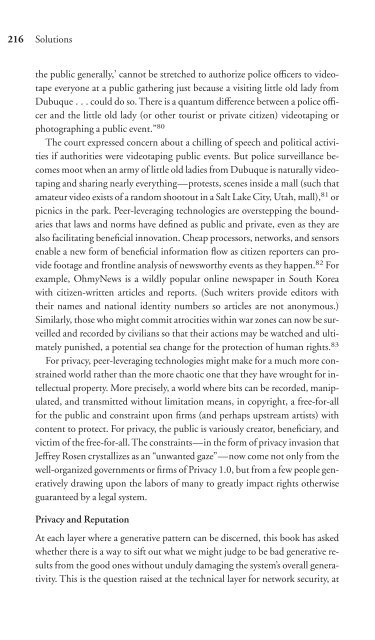Download - Future of the Internet â And how to stop it.
Download - Future of the Internet â And how to stop it.
Download - Future of the Internet â And how to stop it.
Create successful ePaper yourself
Turn your PDF publications into a flip-book with our unique Google optimized e-Paper software.
216<br />
Solutions<br />
<strong>the</strong> public generally,’ cannot be stretched <strong>to</strong> authorize police <strong>of</strong>ficers <strong>to</strong> videotape<br />
everyone at a public ga<strong>the</strong>ring just because a vis<strong>it</strong>ing l<strong>it</strong>tle old lady from<br />
Dubuque ... could do so. There is a quantum difference between a police <strong>of</strong>ficer<br />
and <strong>the</strong> l<strong>it</strong>tle old lady (or o<strong>the</strong>r <strong>to</strong>urist or private c<strong>it</strong>izen) videotaping or<br />
pho<strong>to</strong>graphing a public event.” 80<br />
The court expressed concern about a chilling <strong>of</strong> speech and pol<strong>it</strong>ical activ<strong>it</strong>ies<br />
if author<strong>it</strong>ies were videotaping public events. But police surveillance becomes<br />
moot when an army <strong>of</strong> l<strong>it</strong>tle old ladies from Dubuque is naturally videotaping<br />
and sharing nearly everything—protests, scenes inside a mall (such that<br />
amateur video exists <strong>of</strong> a random shoo<strong>to</strong>ut in a Salt Lake C<strong>it</strong>y, Utah, mall), 81 or<br />
picnics in <strong>the</strong> park. Peer-leveraging technologies are overstepping <strong>the</strong> boundaries<br />
that laws and norms have defined as public and private, even as <strong>the</strong>y are<br />
also facil<strong>it</strong>ating beneficial innovation. Cheap processors, networks, and sensors<br />
enable a new form <strong>of</strong> beneficial information flow as c<strong>it</strong>izen reporters can provide<br />
footage and frontline analysis <strong>of</strong> newsworthy events as <strong>the</strong>y happen. 82 For<br />
example, OhmyNews is a wildly popular online newspaper in South Korea<br />
w<strong>it</strong>h c<strong>it</strong>izen-wr<strong>it</strong>ten articles and reports. (Such wr<strong>it</strong>ers provide edi<strong>to</strong>rs w<strong>it</strong>h<br />
<strong>the</strong>ir names and national ident<strong>it</strong>y numbers so articles are not anonymous.)<br />
Similarly, those who might comm<strong>it</strong> atroc<strong>it</strong>ies w<strong>it</strong>hin war zones can now be surveilled<br />
and recorded by civilians so that <strong>the</strong>ir actions may be watched and ultimately<br />
punished, a potential sea change for <strong>the</strong> protection <strong>of</strong> human rights. 83<br />
For privacy, peer-leveraging technologies might make for a much more constrained<br />
world ra<strong>the</strong>r than <strong>the</strong> more chaotic one that <strong>the</strong>y have wrought for intellectual<br />
property. More precisely, a world where b<strong>it</strong>s can be recorded, manipulated,<br />
and transm<strong>it</strong>ted w<strong>it</strong>hout lim<strong>it</strong>ation means, in copyright, a free-for-all<br />
for <strong>the</strong> public and constraint upon firms (and perhaps upstream artists) w<strong>it</strong>h<br />
content <strong>to</strong> protect. For privacy, <strong>the</strong> public is variously crea<strong>to</strong>r, beneficiary, and<br />
victim <strong>of</strong> <strong>the</strong> free-for-all. The constraints—in <strong>the</strong> form <strong>of</strong> privacy invasion that<br />
Jeffrey Rosen crystallizes as an “unwanted gaze”—now come not only from <strong>the</strong><br />
well-organized governments or firms <strong>of</strong> Privacy 1.0, but from a few people generatively<br />
drawing upon <strong>the</strong> labors <strong>of</strong> many <strong>to</strong> greatly impact rights o<strong>the</strong>rwise<br />
guaranteed by a legal system.<br />
Privacy and Reputation<br />
At each layer where a generative pattern can be discerned, this book has asked<br />
whe<strong>the</strong>r <strong>the</strong>re is a way <strong>to</strong> sift out what we might judge <strong>to</strong> be bad generative results<br />
from <strong>the</strong> good ones w<strong>it</strong>hout unduly damaging <strong>the</strong> system’s overall generativ<strong>it</strong>y.<br />
This is <strong>the</strong> question raised at <strong>the</strong> technical layer for network secur<strong>it</strong>y, at


